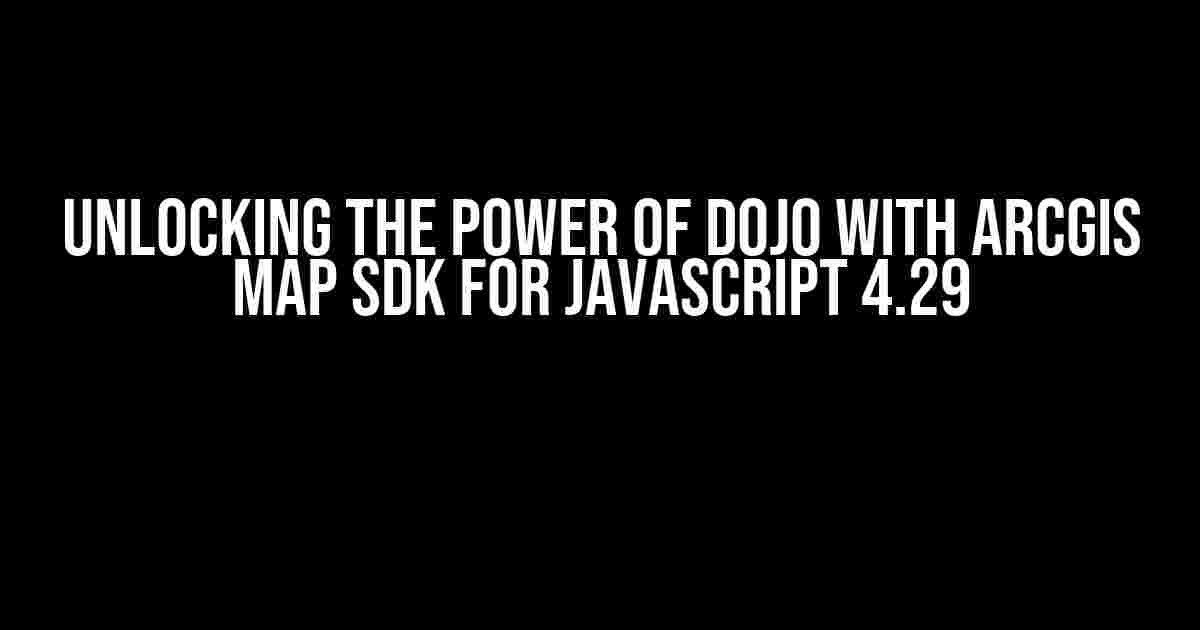Are you ready to take your ArcGIS Map SDK for JavaScript applications to the next level? Look no further! In this comprehensive guide, we’ll dive into the world of Dojo and explore how it can enhance your mapping experiences. By the end of this article, you’ll be equipped with the knowledge to harness the full potential of Dojo with ArcGIS Map SDK for JavaScript 4.29.
What is Dojo?
Dojo is an open-source JavaScript framework that provides a robust set of tools for building high-performance, scalable, and maintainable applications. With its modular architecture and extensive widget library, Dojo has become a popular choice among developers for creating complex, interactive UI components.
Why Use Dojo with ArcGIS Map SDK for JavaScript 4.29?
- Improved Performance**: Dojo’s optimized rendering engine and caching mechanisms ensure that your map applications load quickly and respond smoothly, even with large datasets.
- Enhanced User Experience**: Dojo’s extensive widget library and customizable UI components enable you to create intuitive, engaging, and accessible map interfaces that delight your users.
- Streamlined Development**: Dojo’s modular architecture and AMD (Asynchronous Module Definition) format simplify the development process, allowing you to focus on writing clean, modular code.
Setting Up Dojo with ArcGIS Map SDK for JavaScript 4.29
To get started, you’ll need to install the Dojo toolkit and configure it to work with the ArcGIS Map SDK for JavaScript 4.29. Follow these steps:
npm install dojo(or use a CDN likehttps://js.arcgis.com/4.29/dojo/dojo.js)- Create a new HTML file and add the following code:
<html> <head> <meta charset="utf-8"> <meta name="viewport" content="initial-scale=1, maximum-scale=1, user-scalable=no"> <title>Dojo with ArcGIS Map SDK for JavaScript 4.29</title> <link rel="stylesheet" href="https://js.arcgis.com/4.29/esri/css/main.css"> <script> require(["esri/Map", "dojo/domReady!"], function(Map, domReady) { // Initialize the map var map = new Map("map", { basemap: "streets", center: [-122.45, 37.75], zoom: 4 }); // Add a Dojo widget to the map var button = new Button({ label: "Click me!", onClick: function() { console.log("Button clicked!"); } }); domReady(map.add(button, "top-right")); }); </script> </head> <body> <div id="map"></div> </body> </html>
Working with Dojo Widgets and ArcGIS Map SDK
Now that you have Dojo set up, let’s explore some of the powerful widgets and components that can enhance your map applications.
Button Widget
The Button widget is a fundamental component that can be used to trigger actions, navigate through the map, or display additional information.
var button = new Button({
label: "Zoom to Extent",
onClick: function() {
map.setView({
center: [-122.45, 37.75],
zoom: 12
});
}
});
Accordion Widget
The Accordion widget is perfect for displaying collapsible content, such as legend information or attribute tables.
var accordion = new Accordion({
title: "Legend",
content: "<p>This is the legend content.</p>"
});
DataGrid Widget
The DataGrid widget enables you to display and interact with tabular data, such as feature attributes or query results.
var dataGrid = new DataGrid({
columns: [
{ field: "name", width: "200px" },
{ field: "population", width: "100px" }
],
data: [
{ name: "City 1", population: 100000 },
{ name: "City 2", population: 50000 },
{ name: "City 3", population: 200000 }
]
});
Best Practices for Using Dojo with ArcGIS Map SDK
To ensure a seamless and efficient development experience, follow these best practices when working with Dojo and ArcGIS Map SDK:
- Use AMD format**: Organize your code using the Asynchronous Module Definition (AMD) format to take advantage of Dojo’s modular architecture.
- Declare dependencies**: Clearly declare dependencies using the `require` function to ensure that Dojo widgets and ArcGIS Map SDK components are loaded correctly.
- Use Dojo’s caching mechanisms**: Leverage Dojo’s caching mechanisms to optimize performance and reduce the number of requests to the server.
- Test and debug**: Thoroughly test and debug your application to identify and resolve any compatibility issues or performance bottlenecks.
Conclusion
In this comprehensive guide, we’ve explored the power of using Dojo with ArcGIS Map SDK for JavaScript 4.29. By following the instructions and best practices outlined in this article, you’ll be well-equipped to create high-performance, scalable, and engaging map applications that delight your users.
| Dojo Widget | Description |
|---|---|
| Button | Trigger actions, navigate through the map, or display additional information. |
| Accordion | Display collapsible content, such as legend information or attribute tables. |
| DataGrid | Display and interact with tabular data, such as feature attributes or query results. |
Remember to stay up-to-date with the latest developments in Dojo and ArcGIS Map SDK by following the official documentation and community resources.
Related Resources
- Dojo Official Documentation
- ArcGIS Map SDK for JavaScript Official Documentation
- Dojo Toolkit on GitHub
Happy coding, and don’t hesitate to reach out if you have any questions or need further assistance!
Frequently Asked Question
Get answers to the most common questions about using Dojo with ArcGIS Map SDK for JavaScript 4.29.
What is Dojo and how does it relate to ArcGIS Map SDK for JavaScript 4.29?
Dojo is a JavaScript toolkit that provides a set of utilities and widgets to build dynamic web applications. ArcGIS Map SDK for JavaScript 4.29 uses Dojo as its foundation, allowing developers to create powerful and interactive mapping applications. By leveraging Dojo’s capabilities, developers can build custom UI components, layouts, and workflows for their mapping apps.
What are the benefits of using Dojo with ArcGIS Map SDK for JavaScript 4.29?
The combination of Dojo and ArcGIS Map SDK for JavaScript 4.29 provides several benefits, including improved performance, enhanced UI capabilities, and easier customization. Dojo’s modular architecture and extensibility enable developers to create highly customized and scalable mapping applications, while its built-in support for accessibility and localization makes it easy to reach a broader audience.
Do I need to be an expert in Dojo to use it with ArcGIS Map SDK for JavaScript 4.29?
No, you don’t need to be an expert in Dojo to use it with ArcGIS Map SDK for JavaScript 4.29. The SDK provides a set of pre-built UI components and tools that make it easy to get started with building mapping applications, even if you’re new to Dojo. However, having some basic knowledge of JavaScript and HTML/CSS is recommended.
Can I use other JavaScript libraries or frameworks with ArcGIS Map SDK for JavaScript 4.29 instead of Dojo?
While Dojo is the recommended and default framework for ArcGIS Map SDK for JavaScript 4.29, you can use other JavaScript libraries or frameworks, such as React or Angular, with some additional configuration and customization. However, keep in mind that using a different framework may require more development effort and may not provide the same level of integration and support as Dojo.
Where can I find resources and support for using Dojo with ArcGIS Map SDK for JavaScript 4.29?
You can find extensive documentation, samples, and tutorials on the ArcGIS for Developers website, as well as on the Dojo website. Additionally, the Esri community and Dojo community forums provide a wealth of information and support from experienced developers and experts.



